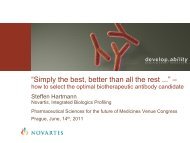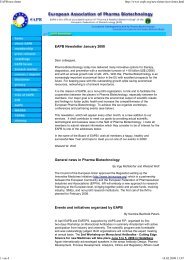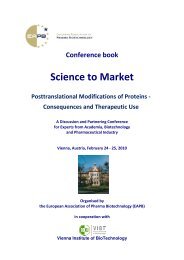Targeted development of biosimilar pharmaceutical products
Targeted development of biosimilar pharmaceutical products
Targeted development of biosimilar pharmaceutical products
You also want an ePaper? Increase the reach of your titles
YUMPU automatically turns print PDFs into web optimized ePapers that Google loves.
<strong>Targeted</strong> <strong>development</strong> <strong>of</strong> <strong>biosimilar</strong><br />
<strong>pharmaceutical</strong> <strong>products</strong><br />
Thomas Stangler, Hannover, Oct. 4th, 2010<br />
EAPB Special Interest Group Regulatory Aspects for Bio<strong>pharmaceutical</strong>s
Sandoz is the world leader in developing,<br />
manufacturing and commercializing <strong>biosimilar</strong>s<br />
Development expertise:<br />
� Pioneer - developing <strong>biosimilar</strong>s since 1996<br />
� Four <strong>development</strong> sites, multiple clinical trials ongoing<br />
� 8-10 molecules in <strong>development</strong>, including mAbs<br />
Six decades <strong>of</strong> biotech manufacturing know-how:<br />
� World leader in fermentation technologies since 1946<br />
� Interferon alpha – first recombinant made in EU in 1980<br />
� Three state-<strong>of</strong>-the-art EU plants for recombinant proteins<br />
Commercial experience:<br />
� Broad global presence<br />
� Strong M&S capability<br />
� Unparalleled market experience with <strong>biosimilar</strong>s<br />
2 | Thomas Stangler | EAPB SIG Regulatory Aspects for Bio<strong>pharmaceutical</strong>s | October 4th, 2010 | Business use only
Sandoz and Novartis have cutting edge biologics<br />
<strong>development</strong> and manufacturing facilities<br />
Vacaville (California)<br />
Microbial production<br />
Holzkirchen/Oberhaching<br />
(Germany)<br />
BU management<br />
Clinical <strong>development</strong><br />
Clinical safety<br />
Pharmacovigilance<br />
Huningue (France)<br />
Cell culture production<br />
Basel (Switzerland)<br />
Product <strong>development</strong><br />
Cell culture production<br />
Menges (Slovenia)<br />
Tech. <strong>development</strong><br />
Cell culture production<br />
3 | Thomas Stangler | EAPB SIG Regulatory Aspects for Bio<strong>pharmaceutical</strong>s | October 4th, 2010 | Business use only<br />
Schaftenau (Austria)<br />
Tech. <strong>development</strong><br />
Cell culture production<br />
Kundl (Austria)<br />
Tech. <strong>development</strong><br />
Regulatory affairs<br />
Microbial production
Biologics are more complex than small molecules…<br />
Acetylsalicylic<br />
Acid<br />
small chemical molecule<br />
Molecular weight<br />
= 180 Daltons<br />
0 amino acids<br />
Calcitonin<br />
simple biologic<br />
Molecular weight<br />
= 3,455 Daltons<br />
~ 32 amino acids<br />
- w/o host cell modifications<br />
- produced in yeast, bacteria<br />
4 | Thomas Stangler | EAPB SIG Regulatory Aspects for Bio<strong>pharmaceutical</strong>s | October 4th, 2010 | Business use only<br />
Monoclonal<br />
Antibody (IgG)<br />
complex biologic<br />
Molecular weight<br />
= 150,000 Daltons<br />
~ 1300 amino acids<br />
- w/host cell modifications<br />
(glycosolations, etc)<br />
- produced in mammalian cells
…and are produced from genetically engineered living<br />
organisms (not chemical synthesis)<br />
Modify host cells<br />
(e.g., bacteria,<br />
mammalian yeast) to<br />
produce recombinant<br />
proteins<br />
Grow cells<br />
under controlled<br />
conditions<br />
(fermentation)<br />
Extract, refold,<br />
purify – generate<br />
drug substance<br />
5 | Thomas Stangler | EAPB SIG Regulatory Aspects for Bio<strong>pharmaceutical</strong>s | October 4th, 2010 | Business use only<br />
.<br />
Formulate to<br />
stable finished<br />
drug product (vial,<br />
syringe, cartridge)
What are Biosimilars?<br />
� Successor to a biological medicinal product for which patent protection<br />
no longer applies<br />
� Complex molecules manufactured by recombinant DNA technology<br />
(insertion <strong>of</strong> gene into the host cell to produce the protein)<br />
� Comparable with the reference product in terms <strong>of</strong> quality, efficacy and<br />
safety<br />
� Can be approved for the same indications for which the reference<br />
product is approved<br />
� Approved by EMA in a centralized procedure � as for innovators<br />
Biosimilars Biosimilars SEBs<br />
6 | Thomas Stangler | EAPB SIG Regulatory Aspects for Bio<strong>pharmaceutical</strong>s | October 4th, 2010 | Business use only<br />
Source:NGx<br />
Generic Biological<br />
Biogenerics
Biosimilars <strong>development</strong> is a hybrid between<br />
traditional generic and originator approaches<br />
Development<br />
investment<br />
Time to market<br />
# <strong>of</strong> patients for approval 1<br />
Generics* Biosimilars* Originators*<br />
US$ 2 – 3m US$ 100 - 200m US$ 800m<br />
2 – 3 yrs 7 – 8 yrs 8 – 10 yrs<br />
20 – 50 pts ~ 500 pts 800 – 1000 pts<br />
1<br />
* Industry average<br />
1 Average estimates for bio<strong>pharmaceutical</strong> trials, e.g., oncology<br />
7 | Thomas Stangler | EAPB SIG Regulatory Aspects for Bio<strong>pharmaceutical</strong>s | October 4th, 2010 | Business use only
Biosimilar competition will lead to increased<br />
innovation<br />
Competition and innovation are inextricably linked – a “virtuous circle”<br />
• Originators should realize fair<br />
pr<strong>of</strong>it and return on investment<br />
• Indefinite monopolies lead to<br />
stagnation<br />
• Biosimilars will increase<br />
competition and encourage “next<br />
wave” <strong>of</strong> biologics innovation<br />
8 | Thomas Stangler | EAPB SIG Regulatory Aspects for Bio<strong>pharmaceutical</strong>s | October 4th, 2010 | Business use only<br />
Innovation<br />
Biosimilars<br />
Competition
Biosimilars: The Regulatory Landscape in EU & USA<br />
Legal basis<br />
The legal framework is provided in<br />
EU Directive 2001/83/EC, in Article<br />
10, Paragraph 4, published in EU<br />
Directive 2004/27/EC and<br />
implemented through-out the EU at<br />
the end <strong>of</strong> Oct 2005.<br />
The requirements are set forth in EU<br />
Directive 2003/63/EC, Annex, Part II,<br />
Point 4, for “Similar Biological<br />
Medicinal Products”.<br />
PHS Act (CBER)<br />
Most biologicals approved under<br />
the PHS Act (e.g. EPO, interferon,<br />
Monoclonal antibodies). Health Care<br />
Reform Bill enacted in March 2010, incl.<br />
Biosimilars - 351(k). Details tbd<br />
Biosimilars<br />
are on a<br />
sound legal<br />
footing in<br />
Europe<br />
Biosimilar<br />
regulations<br />
being<br />
established<br />
in USA<br />
9 | Thomas Stangler | EAPB SIG Regulatory Aspects for Bio<strong>pharmaceutical</strong>s | October 4th, 2010 | Business use only<br />
Further guidelines<br />
In Nov 2004, the EMEA/CHMP<br />
issued a set <strong>of</strong> guidelines for <strong>biosimilar</strong>s<br />
which address general,<br />
quality -relevant and preclinical/<br />
clinical requirements for specific<br />
<strong>products</strong><br />
All general ICH, EMEA, FDA guidelines<br />
on the quality and safety <strong>of</strong><br />
biological <strong>products</strong> apply equally<br />
to bio<strong>pharmaceutical</strong>s and <strong>biosimilar</strong>s<br />
FD&C Act (CDER)<br />
Historically some biologicals<br />
(e.g. somatropin, FSH, insulin) were<br />
approved under the FD&C Act for<br />
which Section 505(b)(2) applies
Biosimilar Guidelines – Overview<br />
Defines<br />
principles<br />
General<br />
guidelines<br />
Quality / Safety<br />
Efficacy<br />
Product class<br />
specific data<br />
requirements<br />
Overarching Guideline (CHMP/437/04).<br />
„Guideline on Similar Biological Medicinal Products.“<br />
Biotechnology – derived proteins<br />
Quality<br />
Nonclinical<br />
Clinical<br />
Insulin Somatropin GCSF Epoetin IFN-a LMWH<br />
Nonclinical<br />
Clinical<br />
Nonclinical<br />
Clinical<br />
Nonclinical<br />
Clinical<br />
Nonclinical<br />
Clinical<br />
10 | Thomas Stangler | EAPB SIG Regulatory Aspects for Bio<strong>pharmaceutical</strong>s | October 4th, 2010 | Business use only<br />
Nonclinical<br />
Clinical<br />
Nonclinical<br />
Clinical<br />
mAbs<br />
under<br />
discussion
Quality: A full quality dossier supplemented by<br />
the demonstration <strong>of</strong> comparability.<br />
Full CTD M3<br />
E.g. 3.2.S DS<br />
-Manufacture<br />
-description MP<br />
-control <strong>of</strong> materials<br />
.control <strong>of</strong> critical steps<br />
.process validation<br />
.manufacturing PD<br />
-Control DS<br />
-Reference standard<br />
-Container closure system<br />
-Stability<br />
Quality<br />
CTD M3+<br />
Comparability<br />
vs. Reference<br />
-Not expected PQA are identical<br />
-Stepwise approach justifying<br />
differences in PQA<br />
-Differences PQA can impact<br />
requirements (non)clinical<br />
package<br />
-Reference product description<br />
11 | Thomas Stangler | EAPB SIG Regulatory Aspects for Bio<strong>pharmaceutical</strong>s | October 4th, 2010 | Business use only<br />
• EMEA/CHMP/BWP/49348/2005<br />
Analytical Methods<br />
& Specifications<br />
-Use <strong>of</strong> state-<strong>of</strong>-the-art<br />
analytical methods<br />
-Physicochemical properties<br />
-Biological activity<br />
-Purity and impurities<br />
-Specifications defined<br />
and justified
Product specific (non)clinical guidance.<br />
Example: Somatropin<br />
(Non)<br />
Clinical<br />
Non-clinical studies Clinical studies<br />
Comparative in nature and designed to detect<br />
differences in pharmaco-toxicological response<br />
Pharmacodynamic studies<br />
-in vitro (receptor-binding, cell proliferation)<br />
-in vivo (weight gain in hypophyse sectomised rats<br />
Toxicological studies<br />
-repeat-dose study<br />
-local tolerance<br />
12 | Thomas Stangler | EAPB SIG Regulatory Aspects for Bio<strong>pharmaceutical</strong>s | October 4th, 2010 | Business use only<br />
• EMEA/CHMP/BMWP/94528/2005<br />
Comparative pharmaco-kinetic and –dynamic<br />
-single dose cross-over study using sc admin<br />
-IGF-1 preferred pharmacodynamic marker<br />
Clinical efficacy & safety<br />
-children with GH deficiency target population<br />
-height velocity as primary end-point<br />
-comparative phase >= 6m, up to 12m<br />
-pre-treatment growth rate >= 6m, up to 18m<br />
-12m immunogenicity data (every 3m)<br />
Pharmacovigilance plan
Biosimilars are recognized around the world as<br />
safe and effective medicines<br />
EU draft<br />
general<br />
guidelines<br />
adopted<br />
Sandoz<br />
Somatropin<br />
first <strong>biosimilar</strong><br />
approved and<br />
launched in EU<br />
Sandoz first<br />
EPO approved<br />
and launched in<br />
EU<br />
Filgrastim*<br />
approved in EU<br />
2004 2005 2006 2007 2008 2009<br />
Sandoz Somatropin<br />
first <strong>biosimilar</strong> – type<br />
medicine approved in<br />
Australia<br />
“We are confident that if a product … gets an MA<br />
from the Commission... the product is as safe<br />
and effective as any other product authorized by<br />
the Commission."<br />
- Nicolas Rossignol, former administrator <strong>of</strong> EC<br />
pharma division 1<br />
1 Source: Speech at EGA Biosimilars conference 2008, quoted in Scrip<br />
* First competitor product (Sandoz product approved Feb 2009)<br />
13 | Thomas Stangler | EAPB SIG Regulatory Aspects for Bio<strong>pharmaceutical</strong>s | October 4th, 2010 | Business use only<br />
Japan regulatory<br />
guidelines<br />
Sandoz<br />
Somatropin first<br />
<strong>biosimilar</strong> approved<br />
and launched in<br />
Japan & Canada<br />
2010<br />
US regulatory<br />
pathway
Target-directed product <strong>development</strong><br />
for late-phase innovative bio<strong>pharmaceutical</strong>s and <strong>biosimilar</strong>s<br />
Refinement<br />
<strong>of</strong> target,<br />
Identification<br />
<strong>of</strong> CQA's<br />
ICH Q8, Q9 and Q10<br />
are applicable for <strong>biosimilar</strong><br />
manufacturers<br />
in the same way as for<br />
originators!<br />
Define Quality Target<br />
Process Development<br />
Building Quality into Product<br />
Quality Risk Management<br />
Thorough process understanding<br />
Confirmation:<br />
Characterization &<br />
Comparability<br />
14 | Thomas Stangler | EAPB SIG Regulatory Aspects for Bio<strong>pharmaceutical</strong>s | October 4th, 2010 | Business use only<br />
Physicochemical<br />
and biological<br />
characterization
Target-directed product <strong>development</strong><br />
for Innovative Bio<strong>pharmaceutical</strong>s and Biosimilars<br />
Define target<br />
Process<br />
<strong>development</strong><br />
Characterization<br />
& Comparability<br />
New bio<strong>pharmaceutical</strong> Biosimilar<br />
Quality: safety, efficacy<br />
Performance: low COGS, robustness, facility-fit<br />
Comparability: to previous clinical DS Comparability: to originator<br />
Start from platform process, rational DoE<br />
Extensive product quality analytics<br />
2-step <strong>development</strong><br />
1-step <strong>development</strong><br />
(early phase, late-phase) → more time to<br />
gain experience with cell line/ product<br />
→ most efficient capacity use<br />
15 | Thomas Stangler | EAPB SIG Regulatory Aspects for Bio<strong>pharmaceutical</strong>s | October 4th, 2010 | Business use only<br />
increased challenge: rarely platform process<br />
useable, tight quality targets to combine with high<br />
yield<br />
Extensive set <strong>of</strong> state-<strong>of</strong>-the-art analytical methods: phys.-chem., biol.<br />
Need to know structure-function relations<br />
better than originator<br />
Pre-clinics – PhI – PhII – PhIII Pre-clinics – PhI – PhIII → No PhII, but<br />
comparative PhI/III studies
<strong>Targeted</strong> Development: timing <strong>of</strong> the 3 steps<br />
(target, <strong>development</strong>, characterisation)<br />
Year 1<br />
Biosimilar:<br />
Originator characterisation<br />
Cell line<br />
dev.<br />
2<br />
Full process<br />
dev.<br />
3<br />
PhI manufacture<br />
4<br />
Process<br />
Charact.<br />
New Bio<strong>pharmaceutical</strong> (timelines exemplary):<br />
Cell line +<br />
Platform<br />
Process<br />
PhI manufacture<br />
Tox.<br />
PoC study<br />
PhII manufacture<br />
5<br />
PhIII man.<br />
+ Process<br />
Validation<br />
Tox. PhI study Phase III study<br />
16 | Thomas Stangler | EAPB SIG Regulatory Aspects for Bio<strong>pharmaceutical</strong>s | October 4th, 2010 | Business use only<br />
Tox.<br />
POC read out<br />
Full process<br />
dev.<br />
PhIII manufacture<br />
Phase II study<br />
6<br />
Process<br />
Charact.<br />
7<br />
Process<br />
Validation<br />
Launch<br />
Manuf.<br />
Phase III study<br />
8<br />
Launch<br />
Manuf.
Starting a <strong>biosimilar</strong> <strong>development</strong> project<br />
� Target Product Pr<strong>of</strong>ile<br />
� Indications<br />
� Dosage strength & form<br />
� Target country & reference product<br />
�� Initial target specification<br />
� Project start:<br />
� Technical & Clinical Development Plan<br />
� Start with QbD Development<br />
17 | Thomas Stangler | EAPB SIG Regulatory Aspects for Bio<strong>pharmaceutical</strong>s | October 4th, 2010 | Business use only<br />
COM<br />
IP<br />
RA<br />
PM<br />
CD<br />
TD<br />
QA
Defining the target!<br />
� Initial target definition (before project start):<br />
� Characterize originator-batches with extensive<br />
set <strong>of</strong> state-<strong>of</strong>-the-art methods<br />
� Develop bioassays reflecting MoA<br />
� First risk-assessment to evaluate CQAs<br />
� Refined target (during project):<br />
� Characterize additional originator batches<br />
� Broad quality ranges obtained during cell line /<br />
process dev. allow establishment <strong>of</strong><br />
correlations phys.-chem. ↔ bioactivity<br />
� Refine definition <strong>of</strong> CQAs<br />
18 | Thomas Stangler | EAPB SIG Regulatory Aspects for Bio<strong>pharmaceutical</strong>s | October 4th, 2010 | Business use only
ICH Q8, Q9 and Q10<br />
19 | Thomas Stangler | EAPB SIG Regulatory Aspects for Bio<strong>pharmaceutical</strong>s | October 4th, 2010 | Business use only<br />
� High level guidance (not<br />
prescriptive)<br />
� Science and risk-based<br />
� Encourages systematic<br />
approaches<br />
� Applicable over the entire<br />
product lifecycle<br />
� Intended to work together<br />
to enhance<br />
<strong>pharmaceutical</strong> product<br />
quality
ICH Q8 concepts for targeted process<br />
<strong>development</strong>: QTPP & CQAs<br />
Quality Target<br />
Product Pr<strong>of</strong>ile<br />
(ICH Q8R2)<br />
Critical Quality<br />
Attributes<br />
(ICH Q8R2)<br />
� A prospective summary <strong>of</strong> the quality characteristics <strong>of</strong> a drug<br />
product that ideally will be achieved to ensure the desired<br />
quality, taking into account safety and efficacy <strong>of</strong> the drug<br />
product.<br />
� Basis <strong>of</strong> design for <strong>development</strong> <strong>of</strong> the product. Considerations<br />
include:<br />
� Intended use in clinical setting, route <strong>of</strong> administration, dosage form, delivery<br />
systems;<br />
� Dosage strength(s);<br />
� Container closure system;<br />
� Therapeutic moiety release or delivery and attributes affecting<br />
pharmacokinetic characteristics;<br />
� Drug product quality criteria (e.g., sterility, purity, stability and drug release).<br />
� Physical, chemical, biological or microbiological property or<br />
characteristic that should be within an appropriate limit, range<br />
or distribution to ensure the desired product quality<br />
20 | Thomas Stangler | EAPB SIG Regulatory Aspects for Bio<strong>pharmaceutical</strong>s | October 4th, 2010 | Business use only
Elements <strong>of</strong> QbD Pharmaceutical Development<br />
QTPP<br />
CQAs<br />
Risk Assessment<br />
� Establish Quality Target Product Pr<strong>of</strong>ile – “the QTPP forms the<br />
basis <strong>of</strong> design for <strong>development</strong> <strong>of</strong> the product“<br />
� Determine Critical Quality Attributes – linking quality attributes to<br />
clinical safety and efficacy (risk-based)<br />
� Linking process parameters to critical quality attributes<br />
Quality – Process �� Based on prior knowledge & process <strong>development</strong> experience<br />
Design Space<br />
Process Knowledge<br />
Control Strategy<br />
Continual<br />
Improvement<br />
� Develop a design space<br />
� Process characterization<br />
� Design and implement control strategy – e.g. by linking CQAs to<br />
process capability and detectability<br />
� Manage product life cycle, including continual improvement<br />
21 | Thomas Stangler | EAPB SIG Regulatory Aspects for Bio<strong>pharmaceutical</strong>s | October 4th, 2010 | Business use only
Quality Attribute Criticality Assessment<br />
A-Mab case study risk assessment tool #1:<br />
Risk ranking & filtering<br />
Criticality = Impact (2-20) × Uncertainty (1-7)<br />
Risk that an attribute<br />
impacts safety and<br />
efficacy (risk score)<br />
Known or potential<br />
consequences on safety<br />
and efficacy, considering:<br />
• Biological activity<br />
• PK/PD<br />
• Immunogenicity<br />
• Safety<br />
Risk scores range between 2 and 140 (criticality continuum)<br />
22 | Thomas Stangler | EAPB SIG Regulatory Aspects for Bio<strong>pharmaceutical</strong>s | October 4th, 2010 | Business use only<br />
Relevance <strong>of</strong> information<br />
e.g. literature, prior knowledge,<br />
in vitro, preclinical, clinical
Typical product quality attributes<br />
Primary & higher order structure<br />
Glyc<strong>of</strong>orms<br />
Charge Variants<br />
Aggregation / Degradation<br />
Process-rel. impurities<br />
Biological characteristics Physicochemical characteristics<br />
Fab<br />
V H<br />
Antigen binding<br />
V L<br />
C L<br />
C H 1<br />
- S - S -<br />
- S - S -<br />
SS SS<br />
-S-S-<br />
SS SS<br />
Heavy chain<br />
23 | Thomas Stangler | EAPB SIG Regulatory Aspects for Bio<strong>pharmaceutical</strong>s | October 4th, 2010 | Business use only<br />
Fc<br />
Effector functions<br />
- Complement interaction<br />
- Fc Receptor interaction<br />
C H 2 C H 3<br />
Heavy chain<br />
-COO -<br />
S S<br />
S S<br />
-NH 3 +<br />
Light chain<br />
SS SS<br />
SS SS<br />
Pyroglutamate formation<br />
Other modifications<br />
-NH 3 + N-terminal heterogeneity<br />
Amino acid modifications<br />
Deamidation, Oxidation, Glycation,<br />
Isomerization<br />
Fragmentation<br />
Cleavage in hinge region, Asp-Pro<br />
Oligosaccharides<br />
Fucosylation, Sialylation, Galactosylation,...<br />
Disulfide Bonds<br />
Free thiols, disulfide shuffling, thioether<br />
C-terminal heterogeneity<br />
Lysine processing, Proline amidation
Bioassays addressing multiple MoAs<br />
CDC<br />
complement<br />
dependent<br />
cytotoxicity<br />
C1<br />
Membrane<br />
attack<br />
complex<br />
Target cell<br />
FcγRIIIa<br />
Blocking/ Inhibiting RB<br />
Dimerization / Shedding / Internalization<br />
PCD<br />
Effector cell<br />
(NK cells)<br />
ADCC<br />
24 | Thomas Stangler | EAPB SIG Regulatory Aspects for Bio<strong>pharmaceutical</strong>s | October 4th, 2010 | Business use only<br />
Antibody dependent<br />
cellular cytotoxicity<br />
Programmed cell death (apoptosis )
Factors Impacting Quality: Curse or Opportunity?<br />
� Host cell line & clone<br />
� Growth medium composition<br />
� Culture conditions (pH, T, aeration...)<br />
� USP type and regime (fed batch, perfusion...)<br />
�� Culture history (genetic stability, process stability...)<br />
� Individual DSP steps<br />
� Hold times & storage (formulation, container, conditions...)<br />
Cell line & process knowledge allows to<br />
• use diversity and variability to our advantage<br />
• design the desired quality into the product<br />
• “to ensure the desired quality, taking into account safety and efficacy”<br />
25 | Thomas Stangler | EAPB SIG Regulatory Aspects for Bio<strong>pharmaceutical</strong>s | October 4th, 2010 | Business use only
QbD Biosimilar Dev.: Managing Variability<br />
Glyc<strong>of</strong>orms<br />
Charge Variants<br />
Biological activity<br />
Process rel. impurities<br />
Aggregates / Degradation<br />
Primary and higher order structure<br />
Target range<br />
Variability at project start<br />
Cell Line Development<br />
Bioprocess Development<br />
DSP Development<br />
DS/DP formulation<br />
Target range<br />
Target range<br />
26 | Thomas Stangler | EAPB SIG Regulatory Aspects for Bio<strong>pharmaceutical</strong>s | October 4th, 2010 | Business use only<br />
Titer<br />
DSP Yield<br />
Scalability<br />
Consistency<br />
Raw Materials<br />
Growth Characteristics
<strong>Targeted</strong> cell line <strong>development</strong>: Drilling down!<br />
Cell lines<br />
Pools Pools Clones Clones Clones Selected<br />
Clone<br />
Hundreds Thousands Hundreds Tens One<br />
96/24/6 well plates Shake flask Lab-scale bioreactor<br />
Primary & higher order structure Glyc<strong>of</strong>orms Charge Variants Aggregation / Degradation Process-rel. impurities Biological activity Titer<br />
27 | Thomas Stangler | EAPB SIG Regulatory Aspects for Bio<strong>pharmaceutical</strong>s | October 4th, 2010 | Business use only<br />
Process Dev .
Quality Attribute [%]<br />
10<br />
Using diversity for targeted cell line <strong>development</strong><br />
� Screening cell lines, pools and<br />
clones to meet quality target<br />
8<br />
6<br />
4<br />
2<br />
0<br />
Parental<br />
Cell Line<br />
Pools<br />
Screening <strong>of</strong> USP conditions<br />
Clones<br />
Cell Line X<br />
Pool A<br />
Clones<br />
Cell Line X<br />
Pool A<br />
Clones<br />
Cell Line X<br />
Pool B<br />
Final Clone<br />
Cell Line X<br />
Pool B<br />
Target<br />
≤ 2 %<br />
� Target defined as comparability<br />
range<br />
� Generate and use diversity<br />
28 | Thomas Stangler | EAPB SIG Regulatory Aspects for Bio<strong>pharmaceutical</strong>s | October 4th, 2010 | Business use only<br />
� Choose the right stage to target a<br />
quality attribute:<br />
– Cell line<br />
– USP<br />
– DSP<br />
– Drug Product<br />
� Cell line, process and product<br />
understanding is key
Charge variant (%)<br />
80<br />
60<br />
40<br />
20<br />
0<br />
Targeting Quality Attributes by Upstream Process<br />
Development<br />
� Defined quality targets as guidance for process <strong>development</strong><br />
� Charge-variants can be adjusted via USP<br />
– process parameters, e.g. pH<br />
– media components<br />
� Glycosylation can be adjusted via USP<br />
– media components<br />
Targeting a<br />
charge variant<br />
via pH in<br />
bioreactor<br />
Target<br />
Range<br />
Charge Variant (%)<br />
14<br />
12<br />
10<br />
8<br />
6<br />
4<br />
2<br />
0<br />
Targeting a charge<br />
variant via media<br />
components in bioreactor<br />
Target<br />
Range<br />
0,0<br />
0,0 0,2 0,4 0,6 0,8 1,0 1,2 1,4<br />
7.2 7.0 6.8<br />
Media Component A<br />
Media Components<br />
29 | Thomas Stangler | EAPB SIG Regulatory Aspects for Bio<strong>pharmaceutical</strong>s | October 4th, 2010 | Business use only<br />
Media Component B<br />
Targeting galactosylation<br />
via media components in<br />
bioreactor<br />
2,0<br />
1,5<br />
1,0<br />
0,5<br />
32,6<br />
43,8<br />
55,0<br />
66,2<br />
77,4<br />
Galactosylation
Fab<br />
Fc<br />
Using variability to identify CQAs<br />
Establishing structure- function relationships<br />
Afucosylated glycans as CQA<br />
Glycosylation impacts<br />
Effector functions<br />
- Complement interaction<br />
- Fc Receptor interaction<br />
- S - S -<br />
- S - S -<br />
� Minor glycan structure with high impact on in vitro potency 1<br />
� Established quantitative relationship between afucosylation<br />
and ADCC potency<br />
� Highly predictive model as ADCC = f(ManX,G0)<br />
1 Shields et al.(2002), Shinkawa et al. (2003), Kanda et al.(2007)<br />
HILIC glycan analysis<br />
30 | Thomas Stangler | EAPB SIG Regulatory Aspects for Bio<strong>pharmaceutical</strong>s | October 4th, 2010 | Business use only<br />
C H2 C H3<br />
Heavy chain<br />
S S<br />
S S<br />
G0<br />
G0F<br />
Man5<br />
21 23 25 27 29 [min]<br />
ADCC potency actual vs predicted<br />
ADCC Actual [%]<br />
500<br />
450<br />
400<br />
350<br />
300<br />
250<br />
200<br />
150<br />
100<br />
ADCC = f(ManX,G0)<br />
RSq=0,99 RMSE=11,298<br />
(filled circles only)<br />
50<br />
50 100 150 200 250 300 350 400 450 500<br />
ADCC Predicted [%] P
QbD for Biosimilars and novel Bio<strong>pharmaceutical</strong>s<br />
QTPP<br />
CQAs<br />
Risk Assessment<br />
CQA – CPP<br />
Design Space<br />
Process Knowledge<br />
Control Strategy<br />
Continual<br />
Improvement<br />
� QTPP is a key concept for targeted and prioritized <strong>development</strong><br />
<strong>of</strong> bio<strong>pharmaceutical</strong>, e.g. <strong>biosimilar</strong>s<br />
� QTPP and CQAs are applicable to both <strong>biosimilar</strong>s and novel<br />
bio<strong>pharmaceutical</strong><br />
� Quality targets for <strong>biosimilar</strong>s can take advantage <strong>of</strong> originator<br />
quality ranges<br />
� No difference in the application <strong>of</strong> ICH Q8 QbD to <strong>biosimilar</strong>s<br />
and novel bio<strong>pharmaceutical</strong>s<br />
� Same standards and requirements for<br />
� Process <strong>development</strong><br />
� Quality risk management<br />
� Design space<br />
� Control strategy<br />
� Product life cycle management and continual improvement<br />
31 | Thomas Stangler | EAPB SIG Regulatory Aspects for Bio<strong>pharmaceutical</strong>s | October 4th, 2010 | Business use only
Sandoz designs processes from the start to<br />
specifically ensure quality and consistency<br />
Proving <strong>biosimilar</strong>ity with comparability<br />
to reference product at all stages<br />
Clinical<br />
Trials<br />
PK/PD<br />
Preclinical<br />
Biological<br />
characterization<br />
Physicochemical<br />
characterization<br />
Process<br />
<strong>development</strong><br />
Analytics<br />
32 | Thomas Stangler | EAPB SIG Regulatory Aspects for Bio<strong>pharmaceutical</strong>s | October 4th, 2010 | Business use only<br />
� Appropriate clinical trials to<br />
show safety / efficacy<br />
� Design manufacturing<br />
processes to ensure<br />
comparability<br />
� Science-based process<br />
<strong>development</strong> to deliver<br />
target quality<br />
� Characterization to prove that<br />
product is safe and efficacious
Final remarks!<br />
� Biosimilars are reality and will continue to gain ground in the future!<br />
– Today: dev. & manufacturing <strong>of</strong> Somatropin, EPO & G-CSF<br />
– The next steps: more complex proteins<br />
� Product quality <strong>of</strong> bio<strong>pharmaceutical</strong>s can be targeted to <strong>biosimilar</strong>ity<br />
through QbD cell line and process <strong>development</strong>. Managing DS<br />
variability is essential!<br />
� Quality: Bio<strong>pharmaceutical</strong>s to be registered via the <strong>biosimilar</strong> pathway<br />
are developed and manufactured according to the same quality<br />
standards as originator <strong>products</strong><br />
� Safety & Efficacy: guaranteed by comparability to the reference product<br />
by characterization <strong>of</strong> physico-chemical properties, biological activity,<br />
and pre-clinical & clinical studies<br />
33 | Thomas Stangler | EAPB SIG Regulatory Aspects for Bio<strong>pharmaceutical</strong>s | October 4th, 2010 | Business use only<br />
Design Design Design specification<br />
specification<br />
specification<br />
Validation Validation Validation<br />
Clinical<br />
Trials<br />
PK/PD<br />
Preclinical<br />
Biological<br />
characterization<br />
Physicochemical<br />
characterization<br />
Process<br />
<strong>development</strong><br />
Analytics
Thanks for listening!<br />
Thanks for contributing!<br />
Mengeš, Schaftenau & Kundl, Oberhaching & Holzkirchen<br />
34 | Thomas Stangler | EAPB SIG Regulatory Aspects for Bio<strong>pharmaceutical</strong>s | October 4th, 2010 | Business use only


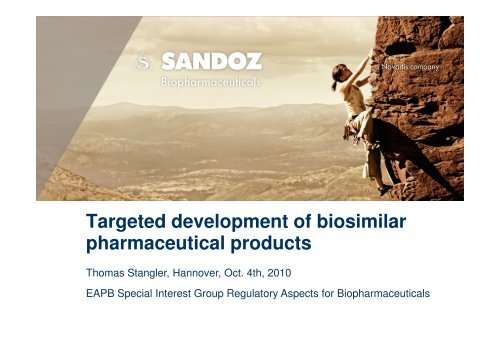
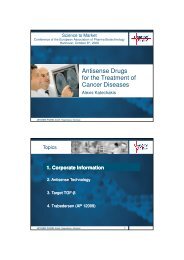
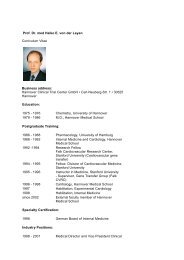



![Roy Forster [Kompatibilitätsmodus]](https://img.yumpu.com/7737040/1/190x135/roy-forster-kompatibilitatsmodus.jpg?quality=85)
